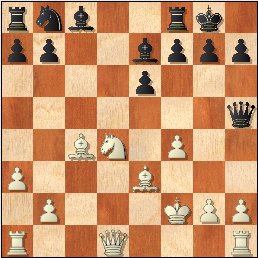
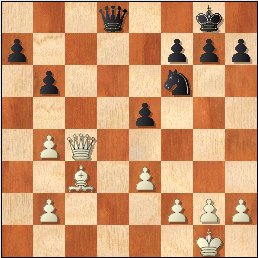
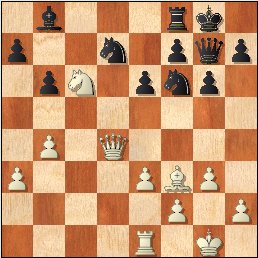
G1: After 14.f2-f4 Qe5-h5+ 15.Ke2-f2
Black played 15...Qxd1?!
G2: After 23.Qh4-c4
Black played 23...Qd1+(!) 24.Qf1 Qxf1+?
G3: After 27.Rc1-e1
Black played 27...Nd5?!
New Chess Exam is Almost Here.
"Play" against a Chess Legend, Rate Your Skills and Improve Your Game
Monthly Special $$ offers - FREE books and Savings
Improve your Chess via Active Learning
ACTIVE LEARNING is any strategy that involves students in doing things and thinking about the things they are doing (*)
Game Review - seeking and finding patterns.
Reviewing your games is the most important aspect of your training. In my book Chess Exam and Training Guide, I have a section devoted to this subject. In short, when reviewing your games, you should strive to:
a. evaluate your opening preparation to see if you need to make adjustments,
b. discover turning points and assess how you handled them
c. identifying and classifying your mistakes
d. discovering new ideas and better moves and practicing them further against a friend or a computer.
As a player, you have 100s of your games available to review and try to indentify your typical mistakes and opportunities for improvement. Of course, spotting a pattern beyond just basic tactical errors that can be quickly pointed by your computer, is an extremely challenging task. If are serious about trying to improve, you may want to seek help from a coach, or a more experienced friend, or even your higher-rated opponent (during the post-mortem review).
Let’s take a very small sample of 3 games played in one day tournament. Is it really possible to uncover some key patterns in only 3 games? Well, I can tell you that often it is! As much as multifaceted game of chess is, and many different things can happen in each game, I see some odd minor things come up again and again. Once identified, many can be fixed on the spot as all you need is to be aware and check for them from time to time. For example, with one of my students we learned that he rushes to attack when one move prophylactics can make his attack so much stronger, with another - that he often misses great possibility to re-deploy his already developed B on another diagonal.
I am a big proponent of an ‘active-learning’ concept. So, rather then only showing you some of my findings from a very recent review, I am also providing you with the games that I got from my student (although omitting his comments, which I often like to see, since I'm commenting not on the moves, but on the thought process). Take a look and see if you can spot any key-patterns. Then compare with my notes below. I'd like to hear your feedback, I'm curious if you were able to find what I found or even something that I didn't identify as a pattern.
Here is the link. CLICK HERE if Java replay doesn't work, use the PGN file at the bottom left on that page.
If you'd rather skip it, scroll down directly to the lecture. Please check my special offers to see if you'd like me to review and annotate your games.
STOP - the lecture begins below.
While reviewing this three games, I have added a number of specific points to the moves in each of them. Additionally, I identified 3 key patterns and pointed them to my student. Subsequently we’ve discussed on what he should do to improve.
I. If you don't know
the opening that occurred in the game well, play a bit more conservatively in
order to avoid sharper lines that could have been well-known and prepared at
home. [A general comment based on games 1 and 2 and even 3, where I saw a bit of
over-aggression with Black in unfamiliar openings.]
II. Q-trades - misplayed to some extent in all 3 games.
 |
 |
 |
|
G1: After 14.f2-f4 Qe5-h5+ 15.Ke2-f2 Black played 15...Qxd1?! |
G2: After 23.Qh4-c4 Black played 23...Qd1+(!) 24.Qf1 Qxf1+? |
G3: After 27.Rc1-e1 Black played 27...Nd5?! |
G1: 15...Qxd1?! [This seems like a safe choice, but ... may not be as White is so far ahead in development. While Black have the Qs, White has to be careful due to his weak K. Now, White just can place the Rs on the c and d-files and attack Black's undeveloped Q-side without any worries (15...Qh4+!? 16.g3 Qf6=/+, Black can even give up a P or two in order to open up the lines and launch an attack)] 16.Rhxd1=, drawn on move 32.
☼ When you are behind in development, trading Qs may not be good for you if your opponent has an exposed K.
G2: 23...Qd1+! [other options are too passive] 24.Qf1 Qxf1+? [Again, this may look like a safe choice - the Ps are symmetrical, the B is limited. However, why trade here? The Black Q is a bit more active and also there is a general rule - Q+N is usually better then Q+B. Granted that, with an accurate play, after either the game move or 24...Qd6!? or 24...Qd5!?, the game is likely to end in a draw. However, I feel that Black's play is easier than White's with the Qs.] 25.Kxf1, later Black erred and lost on move 45.
☼ A general rule - Q+N is usually better then Q+B
G3: 27...Nd5?! This trade of Qs is OK, but wasn't really necessary. At the minimum, it costs Black a P and, possibly could have given White a very active R. [27...e5 28.Qc3 e4 29.Bg2 Re8 30.Rd1 Qf8 Black has no weak spots and an extra N] 28.Bxd5 Qxd4 29.exd4 exd5 30.Ne7+ [I prefer 30.Re7!? with some chances to escape] 30...Kg7 31.Nxd5 -+.
☼ While you want to simplify when having solid material advantage, check what "price" you would pay for this simplifications first.
III. Missing (or not seeking)
intermediate counter-strikes.
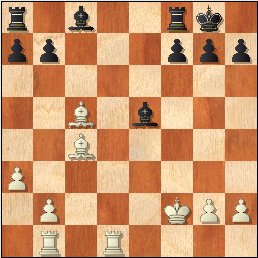 |
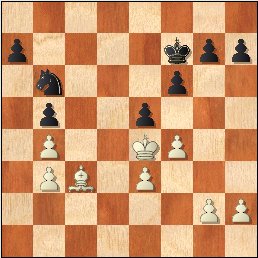 |
|
G1: After 21.Be3-c5 Black played 21...Bf5?! |
G2: After 29.f2-f4 Black played 30...e5xf4? |
G1: 21...Bf5?! [This move allows transposition into a drawn endgame with opposite color Bs. Black panicked, he said that he thought that his R would be trapped due to back-rank checkmate after 21...Re8 22.Bb5 Re6?? 23.Rd8+. In fact, he would be OK after a similar 22...Bf5! 23.Bxe8 Bxb1 with a small advantage for Black.] 22.Bxf8 Bxb1 23.Bxg7=, drawn on move 32.
G2: 30...e5xf4? [This move creates more space for the White B and K, also creates greater separation between the Q-side Ps and the K-side Ps. All favors White, who has the B (a long-ranged piece). Black thought that the capture on f4 was forced, but in fact it wasn't. Instead, 30...Ke6 31.fxe5 Nd5! 32.Bd2 (32.Bb2? f5+ and 33...Nxb4) f6xe5 would enable Black to get his P back reaching a favorable position with a shot to get more than a draw.] 31.Pxf4 Ke6 32.Pf5+ Kd6, with advantage for White, who won on move 45.
Summary:
When reviewing your games, seek to find patterns and typical mistakes, then work on addressing them. Get help, if you can to get objective and insightful review.
==============================================================================================
What do you think about this article? For comments, corrections send email or use this form
Please
check my
special offers to see if you'd like me to review and annotate your games.
More on chess training (serious and enlightening) in my books:
|
|
Chess Exam and Training Guide (2004) $24.95 + shipping Chess Exam and Training Guide: Tactics (2007) $19.95 + shipping CE + CE Tactics (Holiday Special! Free chess cartoon calendar $8, while supplies last) - $39.95 - insured shipping in US is included
The new Chess Exam is coming ... |
Copyrighted @ 2009 Igor Khmelnitsky
For comments or permission to reprint please send inquires via email or this form
(*Bonwell, C., & Eison, J. (1991). Active learning: Creating excitement in the classroom (ASHE-ERIC Higher Education Report No. 1). Washington, DC: George Washington University, p. 2)